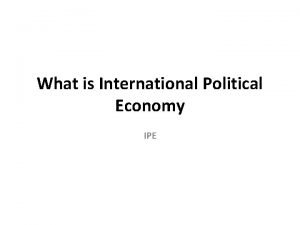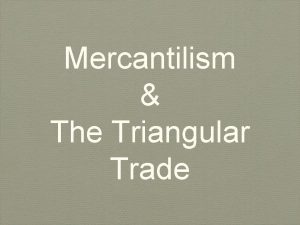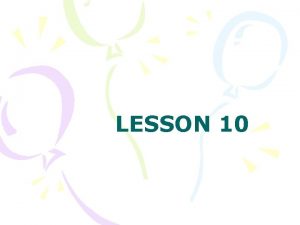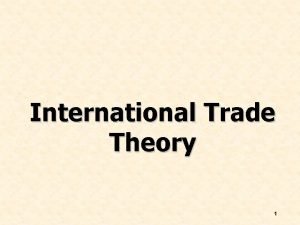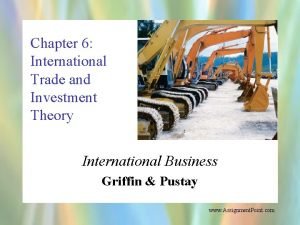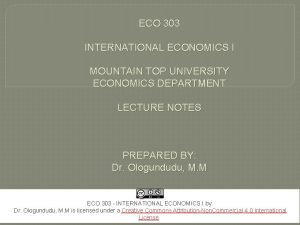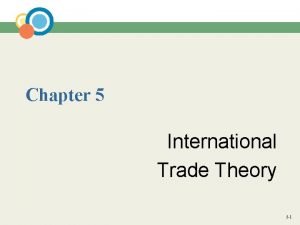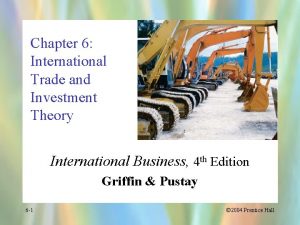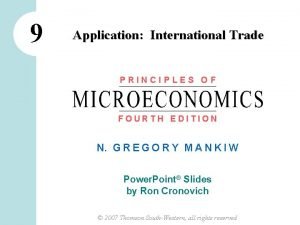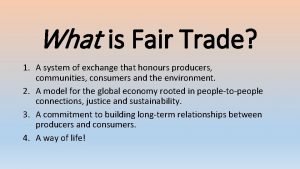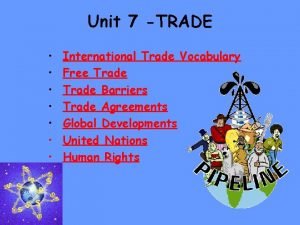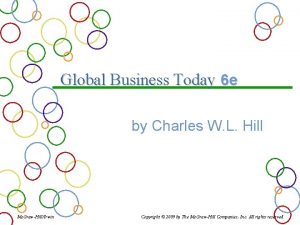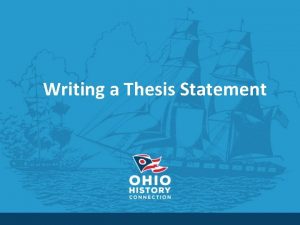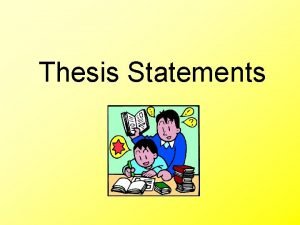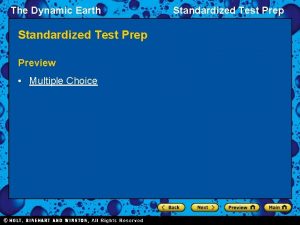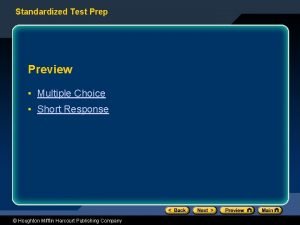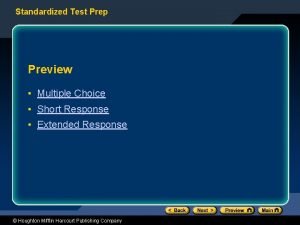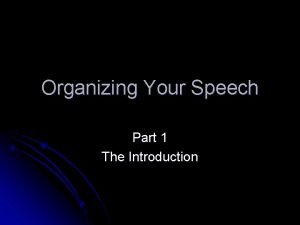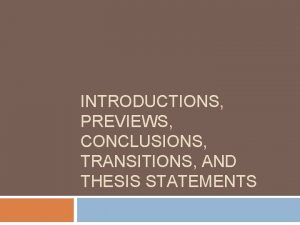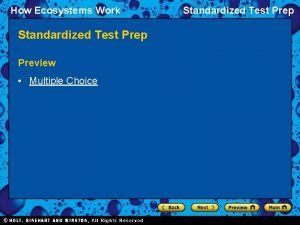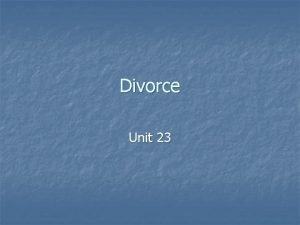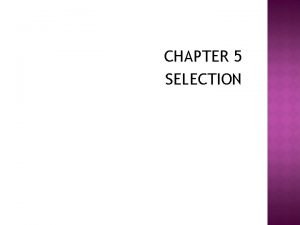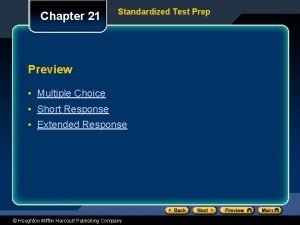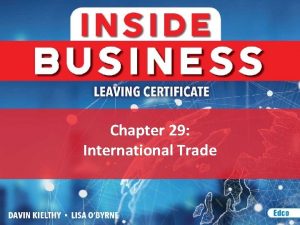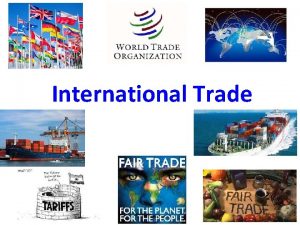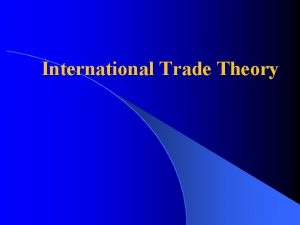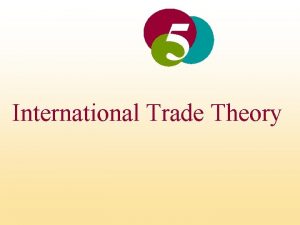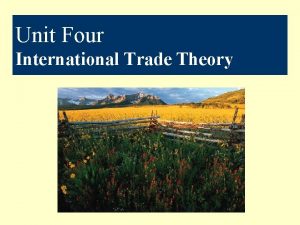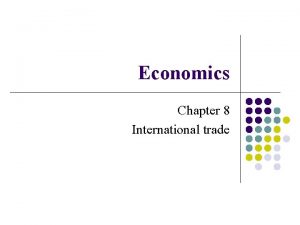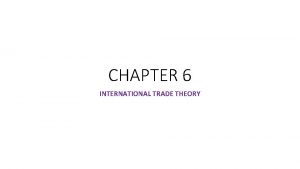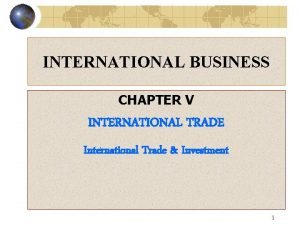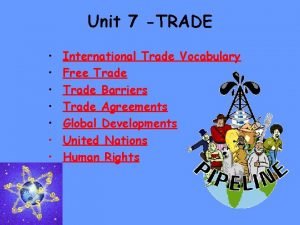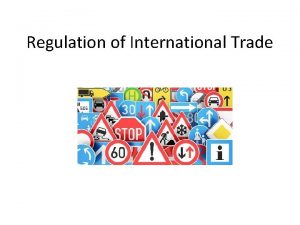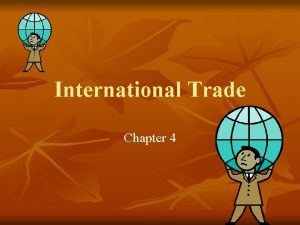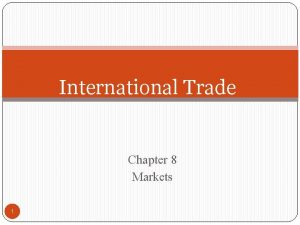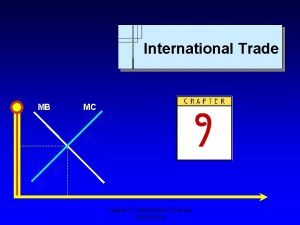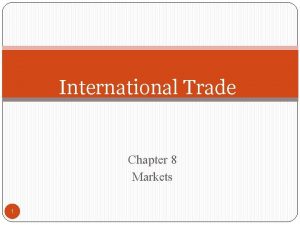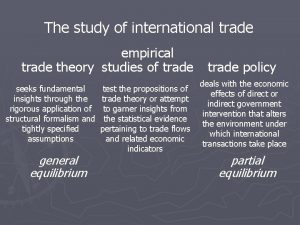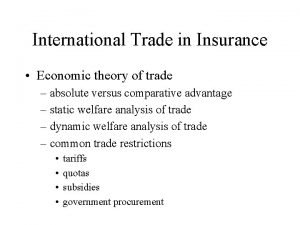International Trade Theory 1 Chapter Preview Discuss the



























- Slides: 27

International Trade Theory 1

Chapter Preview • Discuss the volume and patterns of world trade • Identify the inherent flaws of mercantilism • Explain the absolute and comparative advantage theories • Describe the factor proportions and international product life cycle theories • Explain the new trade and national competitive advantage theories 2

International Trade Purchase, sale or exchange of goods and services across national borders ü People have larger selection of products ü Important engine for job creation 3

Trade and World Output • World trade • 80% merchandise • 20% services • World output impacts trade • Growing output = growing trade • Sluggish output = sluggish trade • World trade grows faster than world output 4

World’s Top Exporters 5

Trade Patterns Merchandise trade among: Low- and middle-income nations High-income and low- and middle-income nations Western European trade is mostly intraregional trade High-income nations North America imports twice as much from Asia as it exports to Asia 6

Who Trades with Whom? 7

Trade and the Dependent Nation Total dependence Total independence Potential effects of dependence: + Infuses needed capital + Creates jobs and raises wages + Imports technology and skills – Economic problems transferred – Political turmoil can spill over 8

Trade Theory Timeline 9

Mercantilism Nations accumulate financial wealth by encouraging exports and discouraging imports Three pillars • Maintain trade surplus • Government intervention • Exploit colonies Inherent flaws • World trade is zero-sum game • Constrains output and consumption • Limits colonies’ market potential 10

Absolute Advantage Ability of a nation to produce a good more efficiently than any other nation (greater output using same or fewer resources) Riceland 1 resource unit = 1 ton rice or 1/5 ton tea Tealand 1 resource unit = 1/6 ton rice or 1/3 ton tea Specialization and trade allows each to produce and consume more 11

Trade Gains: Absolute Advantage 12

Comparative Advantage Inability of a nation to produce a good more efficiently than other nations, but an ability to produce that good more efficiently than it does any other good Riceland 1 resource unit = 1 ton rice or 1/2 ton tea Tealand 1 resource unit = 1/6 ton rice or 1/3 ton tea Specialization and trade allows each to produce and consume more 13

Trade Gains: Comparative Advantage 14

Assumptions and Limitations 1. Nations strive only to maximize production and consumption 2. Only two countries produce and consume just two goods 3. No transportation costs of trading goods 4. Labor is the only resource used to produce goods 5. Ignores efficiency and improvement gains from producing just one good 15

Factor Proportions Theory Countries produce and export goods that require resources (factors) in abundance, and import goods that require resources in short supply Labor Land Capital Two factor types 16

Leontief Paradox Research discovered evidence opposite the prediction of factor proportions theory ü US exports are more labor-intensive than US imports Possible explanation ü Theory assumes nation’s production factors to be homogeneous ü Theory is better predictor when expenditures on labor are considered 17

International Product Life Cycle A company begins by exporting its product and later undertakes foreign direct investment as a product moves through its life cycle 18

New Trade Theory Fundamentals First-mover advantage Ø Gains from specialization and increasing economies of scale Ø Ø Companies first to market create barriers to entry Economic and strategic advantage of being first to enter an industry Ø Ø Government may help by assisting home companies May create a formidable barrier to market entry for potential rivals 19

National Competitive Advantage Nation’s competitiveness in an industry depends on the industry’s capacity to innovate and upgrade, which in turn depends on four main determinants (plus government and chance) Factor conditions Demand conditions Related and supporting industries Firm strategy, structure and rivalry 20

Factor Conditions Basic factors Advanced factors Nation’s resources Result of investing in education and innovation (large workforce, natural resources, climate and surface features) (skill of workforce segments, technological infrastructure) Basic factors can spark initial production, but advanced factors account for sustained competitive advantage 21

Demand Conditions Sophisticated home-market buyers drive companies to improve existing products and develop entirely new products and technologies This should improve the competitiveness of the entire group of companies in a market 22

Related and Supporting Industries Companies in an internationally competitive industry do not exist in isolation Supporting industries form “clusters” of economic activity in the geographic area Each industry reinforces the competitiveness of every other industry in the cluster 23

Mapping U. S. Clusters 24

Firm Strategy, Structure and Rivalry Ø Highly skilled managers are essential because strategy has lasting effects on firm competitiveness Ø Domestic industry whose structure and rivalry create an intense struggle to survive, strengthens its competitiveness 25

Chapter Summary • This chapter presents the main theories that developed over time to explain the occurrence of international trade following a brief overview of trade benefits, volume, and patterns. Mercantilism states that nations should accumulate financial wealth, usually in the form of gold, by encouraging exports and discouraging imports. Absolute advantage states that a nation should concentrate in the production and export of those products in which it has an absolute advantage and import products it needs but does not produce. Comparative advantage states that trade will still benefit two countries even if one country is a less efficient producer. Factor proportions theory states that countries produce and export goods that require resources (factors) that are abundant and import goods that require resources in short supply. The international product life cycle theory states that a company will begin by exporting its product and later undertake foreign direct investment as the product moves through its life cycle. The new trade theory argues that 1) there are gains from specialization and increasing economies of scale, 2) companies first in a market create barriers to entry, and 3) governments can assist their home-based companies. National competitive advantage theory states that a nation’s competitiveness in an industry depends on the capacity of the industry to innovate and upgrade. 26

Thanks 27
 Amateurs discuss tactics professionals discuss logistics
Amateurs discuss tactics professionals discuss logistics Ipe is
Ipe is Mercantilism theory of international trade
Mercantilism theory of international trade Current theory of international trade adalah
Current theory of international trade adalah International trade theory
International trade theory International trade theory
International trade theory New trade theory
New trade theory Modern theory of trade
Modern theory of trade Eco 303
Eco 303 Product life cycle theory of international trade
Product life cycle theory of international trade Firm based trade theory
Firm based trade theory Chapter 9 application: international trade answers
Chapter 9 application: international trade answers Is free trade fair? discuss
Is free trade fair? discuss Vocabulary international trade
Vocabulary international trade New trade theory
New trade theory Thesis essay
Thesis essay Summary thesis statement
Summary thesis statement Test prep preview
Test prep preview Test prep preview
Test prep preview Test prep preview
Test prep preview Test prep preview
Test prep preview Sccm technical preview
Sccm technical preview Preview statement speech example
Preview statement speech example Thesis and preview statement example
Thesis and preview statement example Test prep preview
Test prep preview Nnn preview
Nnn preview The selection preview
The selection preview Chapter 21 standardized test practice answers
Chapter 21 standardized test practice answers

